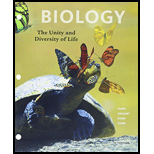
Concept explainers
The number of species on an island depends on the size of the island and its distance from a mainland. This statement would most likely be made by _____.
- a. an explorer
- b. a biogeographer
- c. a geologist
- d. a philosopher
Introduction: Biogeography is the branch of science that deals with the study of various species of animals and plants that had geographically distributed throughout the geological time. The person who studies about the biogeography is known as biogeographer.
Answer to Problem 1SQ
Correct answer: The number of species on an island depends on the size of the island and its distance from the mainland. This statement would most likely be made by a biogeographer.
Hence, the correct answer is option b.
Explanation of Solution
Reason for correct answer:
During the late 1800s, the naturalists started to bring thousands of animals and plants from various parts of the world. They observed the various patterns in different species and also the resemblance in their body parts. Due to this observation, they thought how the natural forces can be able to shape the life in different species. Thus, these studies regarding the various patterns of species in the geographic distribution and its communities were referred as biogeography, and the person who deals with these studies is known as biogeographer. For example, the number of species staying in an island can depend upon various factors including the size of the island in which they live and the distance from their mainland. This can be predicted by the biogeographer.
Option b. is given as “a biogeographer”.
The person who studies about the geographic distribution throughout the geological time is referred as a biogeographer.
Hence, the correct answer is option a.
Reason for incorrect answer:
Option a. is given as “an explorer”.
An explorer is a person who travels or explores new places. These people do not study about the species that is geographically distributed.
Hence, option a. is incorrect.
Option c. is given as “a geologist”.
The person who studies about the earth science and its processes is referred to as a geologist. These people do not study about the species that is geographically distributed.
Hence, option c. is incorrect.
Option d. is given as “a philosopher”.
The person who studies about the philosophy is referred to as a philosopher. These people do not study about the species that is geographically distributed.
Hence, option d. is incorrect.
Hence the options a., c., and d. are incorrect.
Want to see more full solutions like this?
Chapter 16 Solutions
Bundle: Biology: The Unity and Diversity of Life, Loose-leaf Version, 14th + MindTap Biology, 2 terms (12 months) Printed Access Card
Additional Science Textbook Solutions
Genetics: From Genes to Genomes
MARINE BIOLOGY
Microbiology: Principles and Explorations
Genetics: From Genes to Genomes, 5th edition
Microbiology: An Introduction
Human Physiology: An Integrated Approach (7th Edition)
- The number of species on an island usually depends on the size of the island and its distance from a mainland. This statement would most likely be made by _______. a. an explorer c. a geologist b. a biogeographer d. a philosopherarrow_forwardWhich two extinction risks may be a direct result of the pet trade? a. climate change and exotic species introduction b. habitat loss and overharvesting c. overharvesting and exotic species introduction d. habitat loss and climate changearrow_forwardWhich term describes the process whereby toxic substances increase along trophic levels of an ecosystem? a. biomassification b. biomagnification c. bioentropy d. heterotrophyarrow_forward
- Populationecologists do not study:a.reproductive ecology.b.distribution and abundance.c.energy flow.d.extinction.e.adaptation.arrow_forwardA creek provides habitat and breeding sites for several different amphibian species. Which scale of life represents the interactions between the amphibians and the creek? a. population b. biome c. ecosystem d. community aarrow_forwardA group of lions that preys on deer constitutes which ecological level? A: population B: ecosystem C: community D: biomearrow_forward
- Which of these contributed to humans beginning to abandon a hunter-gatherer lifestyle approximately 15,000 to 10,000 years ago? a)climate change b)extinction of large pray c)domesticating animals d)growing crops, resulting in increased food supply e)all of the abovearrow_forwardStudies of preagricultural populations indicate that compared to people today, Paleolithic people ate a. food that contained more fat and less fiber. b. food that had fewer essential nutrients. c. mostly meat. d. a wider variety of food.arrow_forwardThe study of how habitat-type distribution across a landscape is known as: A. Landscape Ecology B. Evolutionary Ethology C. Population Biology D. Conservation Biologyarrow_forward
- A researcher wanted to know if introduced predators (lake trout, a fish) caused a decrease in the abundance of yellow-legged frogs. The ecologist measured the density of frogs (number frogs per meter of shoreline of a lake) in lakes that did not have any introduced predators (fish absent), lakes that had previously introduced predators (fish present), and lakes from which he removed the predators (fish removed), and then recorded if frog density increased, decreased, or stayed the same over one year. part a: What was the role in the experiment of the “fish present” lakes? Group of answer choices A. subjects B. experimental group C. positive control group D. negative control group E. standardized condition part b: This study focused primarily on ______________ ecology. Group of answer choices A. organismal B. population C. community D. physiological E. biospherearrow_forwardIn birds, where have most of the recent extinctions taken place? a. In outer space b. At sea c. On islands d. On continentsarrow_forwardOwners of off-road recreational vehicles would like increased access to government-owned deserts. Some argue that it is the perfect place for off-roaders because Theres nothing there. Why do biologists disagree?arrow_forward
 Biology Today and Tomorrow without Physiology (Mi...BiologyISBN:9781305117396Author:Cecie Starr, Christine Evers, Lisa StarrPublisher:Cengage Learning
Biology Today and Tomorrow without Physiology (Mi...BiologyISBN:9781305117396Author:Cecie Starr, Christine Evers, Lisa StarrPublisher:Cengage Learning
 Concepts of BiologyBiologyISBN:9781938168116Author:Samantha Fowler, Rebecca Roush, James WisePublisher:OpenStax College
Concepts of BiologyBiologyISBN:9781938168116Author:Samantha Fowler, Rebecca Roush, James WisePublisher:OpenStax College


